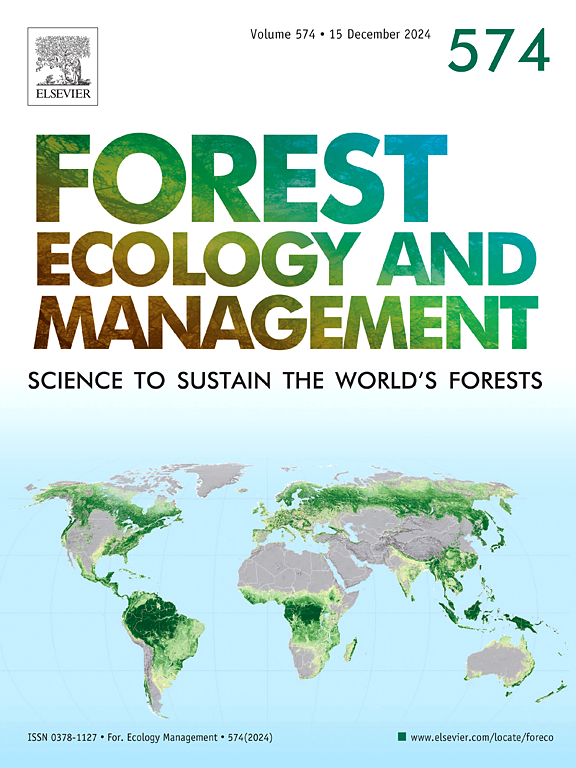Promoting effect of tree mixture on litter quality and microbial diversity governs microbial necromass accrual in previously degraded soils
IF 3.7
2区 农林科学
Q1 FORESTRY
引用次数: 0
Abstract
Introducing broadleaf tree species into pine forests has been widely adopted as a strategy to mitigate forest degradation and enhance soil carbon sequestration. However, the microbial-mediated mechanisms underlying the effects of mixed coniferous-broadleaf forests on soil carbon sequestration in degraded forest ecosystems remain inadequately elucidated. This study investigated two previously degraded sites in southern China, presenting vegetation cover since 1981 and 2000, respectively. Within these sites, single Pine (Pinus massoniana) plantations and mixed plantations of pine and broadleaf species (Pine+Schima superba) were established as part of restoration efforts. Amino sugars were quantified as biomarkers of topsoil (0–10 cm) microbial necromass, and microbial community diversity and structure were assessed via high-throughput sequencing techniques (16S rRNA and ITS sequencing) and phospholipid fatty acids analysis. Our results showed that tree mixture increased soil microbial necromass, with the fungal necromass increasing more rapidly than bacterial necromass, suggesting that fungal necromass rapidly responds to tree species mixture effects, but bacterial necromass drives the sustained accumulation of microbial necromass C in the later restoration stages. Furthermore, mixed plantation soils yield higher bacterial α-diversity (Chao1), and ectomycorrhizal fungi abundance, all of which positively influence microbial necromass accumulation. Structural equation modelling results showed that tree mixture strengthens the integrated effects of litter quality and soil nitrogen status on microbial community composition (16S rRNA and ITS sequencing) and functions (FUNGuild) and thus enhancing microbial necromass. Importantly, this ecological restoration effect shifted microbial necromass regulation from dual independent pathways (physicochemical vs. microbial factors) to an integrated soil-microbial feedback loop, with mixed pine-broadleaf plantations enhancing the interaction between soil nutrient availability and microbial functional diversity to promote microbially-derived carbon accrual in soils. These findings demonstrate that introducing tree species with high-quality litter constitutes an effective vegetation restoration strategy, simultaneously accelerating soil organic matter sequestration in degraded pine forest ecosystems.
混合树种对凋落物质量和微生物多样性的促进作用控制着退化土壤中微生物坏死块的累积
在松林中引入阔叶树种已被广泛采用作为缓解森林退化和增强土壤固碳的策略。然而,在退化森林生态系统中,混交林对土壤固碳影响的微生物介导机制尚未得到充分阐明。本研究调查了中国南方两个退化地,分别显示了1981年和2000年以来的植被覆盖情况。在这些地点内,建立了单一的马尾松人工林和松与阔叶物种(松+木片)的混合人工林,作为恢复工作的一部分。将氨基糖作为表层土壤(0-10 cm)微生物坏死块的生物标志物进行量化,并通过高通量测序技术(16S rRNA和ITS测序)和磷脂脂肪酸分析评估微生物群落多样性和结构。结果表明,树木混合增加了土壤微生物坏死块,其中真菌坏死块的增加速度快于细菌坏死块,表明真菌坏死块对树木混合效应的反应迅速,但细菌坏死块在后期恢复阶段驱动微生物坏死块C的持续积累。此外,混合人工林土壤具有较高的细菌α-多样性(Chao1)和外生菌根真菌丰度,这些都是微生物坏死块积累的积极影响因素。结构方程模型结果表明,混合乔木增强了凋落物质量和土壤氮状态对微生物群落组成(16S rRNA和ITS测序)和功能(FUNGuild)的综合影响,从而增强了微生物坏死群。重要的是,这种生态恢复效应将微生物坏死块调节从双重独立途径(物理化学与微生物因素)转变为一个综合的土壤-微生物反馈回路,混合松林阔叶人工林增强了土壤养分有效性和微生物功能多样性之间的相互作用,促进了土壤中微生物来源的碳积累。这些结果表明,在退化松林生态系统中,引入具有优质凋落物的树种是一种有效的植被恢复策略,同时加速了土壤有机质的固存。
本文章由计算机程序翻译,如有差异,请以英文原文为准。
求助全文
约1分钟内获得全文
求助全文
来源期刊

Forest Ecology and Management
农林科学-林学
CiteScore
7.50
自引率
10.80%
发文量
665
审稿时长
39 days
期刊介绍:
Forest Ecology and Management publishes scientific articles linking forest ecology with forest management, focusing on the application of biological, ecological and social knowledge to the management and conservation of plantations and natural forests. The scope of the journal includes all forest ecosystems of the world.
A peer-review process ensures the quality and international interest of the manuscripts accepted for publication. The journal encourages communication between scientists in disparate fields who share a common interest in ecology and forest management, bridging the gap between research workers and forest managers.
We encourage submission of papers that will have the strongest interest and value to the Journal''s international readership. Some key features of papers with strong interest include:
1. Clear connections between the ecology and management of forests;
2. Novel ideas or approaches to important challenges in forest ecology and management;
3. Studies that address a population of interest beyond the scale of single research sites, Three key points in the design of forest experiments, Forest Ecology and Management 255 (2008) 2022-2023);
4. Review Articles on timely, important topics. Authors are welcome to contact one of the editors to discuss the suitability of a potential review manuscript.
The Journal encourages proposals for special issues examining important areas of forest ecology and management. Potential guest editors should contact any of the Editors to begin discussions about topics, potential papers, and other details.
 求助内容:
求助内容: 应助结果提醒方式:
应助结果提醒方式:


